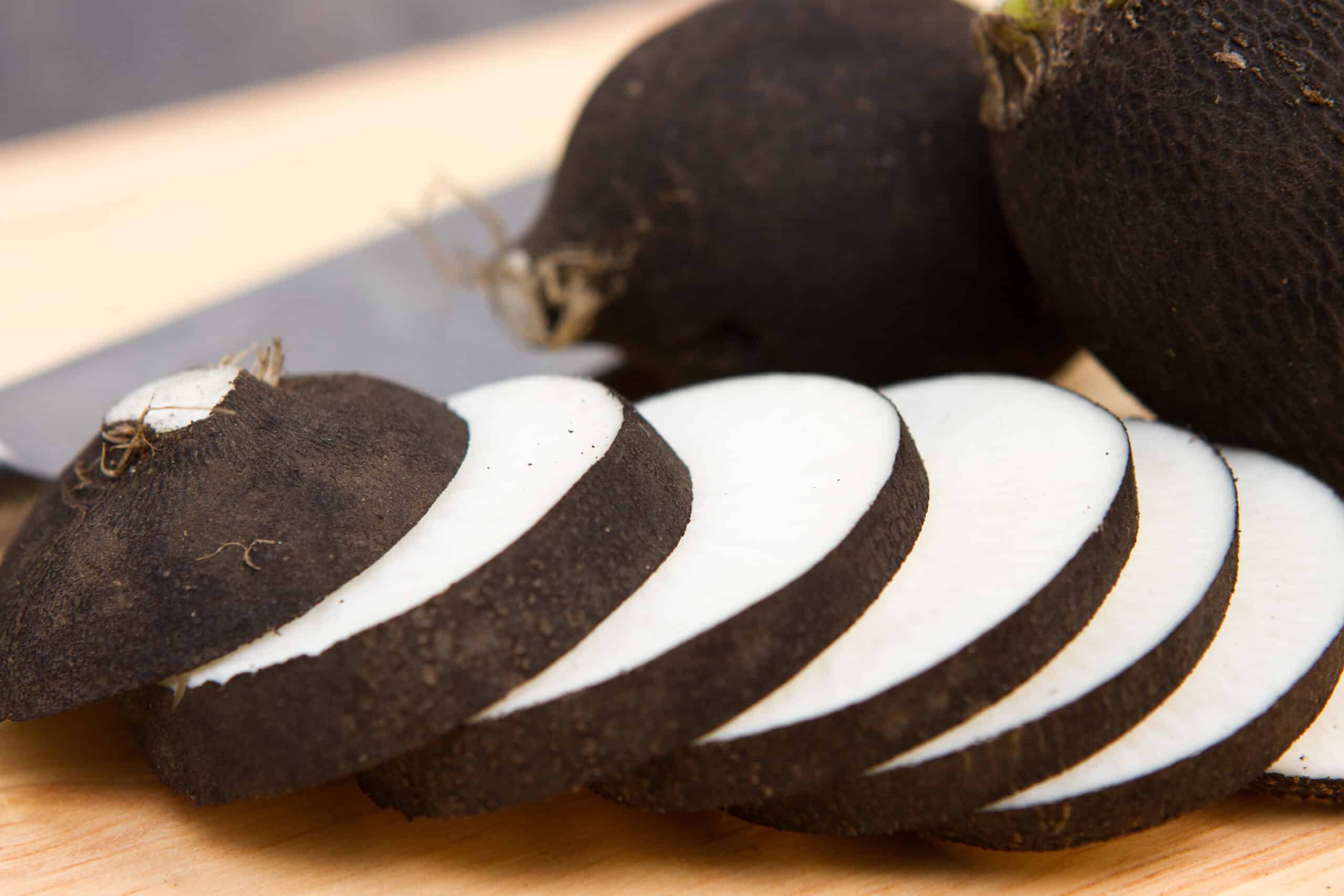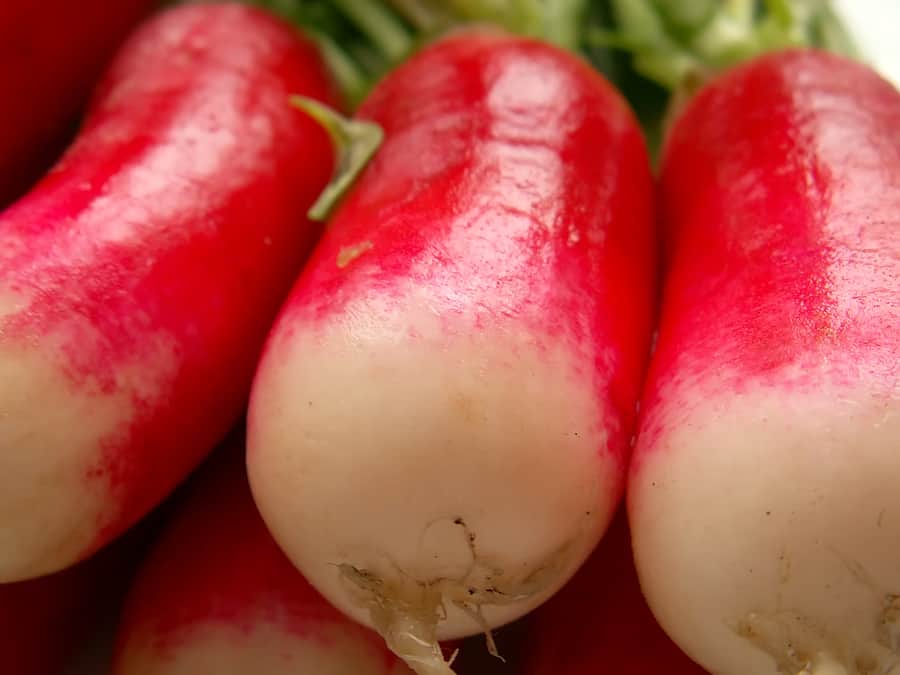Radishes are commonly eaten raw but they are also quite delicious cooked in butter. Radishes can taste mild and sweet or peppery and pungent.
Common round and oblong radishes can be bright pink to crimson red, purple, and white. Daikon radishes –common in Asian cooking–are ivory. Black radishes–a winter radish–are spicy hot.
Also of interest:

Radishes are a quick-growing, cool-season crop.
Favorite radish recipes
Radish Root and Leafy Green Salads
Savory Radish-Cabbage Coleslaw
Types of radishes
- Red Round. The most familiar radish is the round or oval red radish. Varieties like ‘Champion’, ‘Cherry Belle’, and ‘Comet’ are the ones you likely will find at your farm market. These radishes have a solid, crisp, white flesh.
- The red, round radish is mild tasting in spring and grows more peppery as the weather warms. The red radish is one you can slice and eat sandwiched with bread and butter or as an hors d’oeuvre.
- French breakfast. The second most familiar radish is the French breakfast radish. It is shaped like a small carrot with red skin tapering to white at the root end and white flesh. This radish is mild enough to eat for breakfast—like the French do–and is often served with other raw vegetables as crudités.
- White daikon. The large white radish or daikon (its Japanese name) has long been popular in Asian countries. It has a cucumber shape, and white flesh, and is more peppery tasting than most red radishes. It grows mild with cooking and so is served cooked at breakfast, lunch, and dinner in many Asian countries.
- (Another white radish—much smaller than the daikon—but still an elongated, tapered radish is called ‘Icicle’. White icicle radishes are milder tasting than red radishes.)
- Black radish. The black radish—the size of a large red radish or turnip but dull black–is almost as pungent as the horseradish. It requires draining—treatment with salt—or cooking to make it easily edible. The black radish—which is sometimes called the black Spanish radish—is drier than other radishes and is a favorite in Eastern Europe where it is often paired with sour cream or seafood.
- Watermelon radish. Watermelon radish is about the size and shape of black radish with green outer skin and pink to red-color interior that radiates out from its center. The watermelon radish is sweet and crunchy.
- Korean radish. Korean radish is a large turnip-sized root that has a jade green skin and flesh that ranges from green to white. It is a juicy, sweet-tasting radish.

How to choose radishes
- Select a radish that is well-formed, and feel firm when it is gently squeezed. If it gives to pressure, the interior will likely be pithy, not crisp.
- Radishes should be free of blemishes, cuts or cracks, or yellowing. The attached leaves should be green and crisp.
- Black radishes should be heavy and free of cracks.
- Daikon and Korean radishes should be evenly shaped and firm with a glossy sheen.

How to store radishes
- Radishes can be stored in a plastic bag in the refrigerator for up to 5 days.
- Trim off green tops before storing.
- Wash and trim the root end just before using.

How to prepare radishes
- Wash radishes in cool water before serving, trim off the stem end and tip, and peel if desired.
- Daikons have thin skin that can be simply removed by vigorous scrubbing.
- Black radishes should be scraped, scrubbed, and peeled before cooking.

Radish serving suggestions
- Radishes can be served raw in appetizers, salads, sandwiches, or dip.
- Most radishes can be served raw or cooked. Here are some ideas for serving radishes:
- Refrigerate in water to make them crisper and remove pungency.
- Serve raw in salads, as garnishes, and for crudités.
- Serve fresh with sweet butter and salt.
- Finely slice and serve in a sandwich with bread and butter.
- Slice radishes and onions into very thin rounds and toss with finely chopped fresh mint, olive oil, and lemon juice.
- Slice into a salad of oranges and walnuts with a scattering of arugula and dress with a walnut oil vinaigrette.
- Grate raw carrots and radishes with sweet-and-sour dressing and serve as a side dish.
- “Pickle’ by mincing and marinating in vinegar.
- Make fans or “radish roses” by slicing several times across the top and down almost to the bottom. Place in iced water until the petals open and turn back.
Radish cooking suggestions
- Cooked radishes can be added to soups, stews, omelets, and stir-fries.
- A radish is cooked best when it is crisp-tender to fully tender but not mushy.
- Radish greens can be prepared and cooked like spinach when they are fresh and tender.
- Sauté sliced radishes quickly until crisp-tender in butter or olive oil, season with a dusting of sugar, freshly ground pepper, and salt.
- Braise radishes in butter or cook with a cream sauce.
- Stir-fry radish slices at the very last minute. Shredded daikon is good in stir-fries.
- Use the piquant flavor of radish sprouts to flavor soups, sandwiches, omelets, or tofu.
- Steamed or sauté green radish tops. Radish greens can be prepared like spinach.

Radish flavor partners
- Radishes have a flavor affinity for chicken livers, chives, lettuce, mild fish, mint, scallions, scallops, smoked salmon, sweet butter, and vinaigrette.
Radish nutrition
- Radishes are a good source of vitamin C and potassium and supply folic acid.

Get to know radishes
- Radishes can be small and round, large and round, oval, oblong, and long. A cherry radish can be about ½ inch (13 mm) in diameter—about the size of a cherry, and the carrot-like giant daikon can grow to 1½ feet (45 cm) in length.
- Radishes can be red, white, red and white, pink, purple, green, or black and many shades in between, and their interior flesh can be almost as many colors.
- Round, red radishes are often called spring radishes because that’s when they are grown and harvested. But radishes grow in mild, cool climates throughout the year.
- The name radish comes from the Latin word radix meaning root.
- Radishes are members of the mustard family. The mustardy tang or pungency of a radish comes from an essential oil that is concentrated near the surface just beneath the skin. Just how mild or peppery a radish tastes depends upon the variety, the age, and even the soil in which it was grown.
- Radishes are native to the eastern Mediterranean but have made their way around the world. Radishes have been used as food since prehistoric times in Europe, China, and Japan.
The botanical name for the radish is Raphanus sativus.
Radish articles on Harvest to Table:
How to Plant, Grow, and Harvest Radishes
Radish Growing Problems Troubleshooting
Tasty Ways to Cook and Serve Radishes
Radish Root and Leafy Green Salad
How to Make Savory Radish-Cabbage Coleslaw
Articles of interest:
Best Herbs for Container Growing
Garden Planning Books at Amazon:
- Vegetable Garden Almanac & Planner
- Kitchen Garden Grower’s Guide Vegetable Encyclopedia
- Vegetable Garden Grower’s Guide
- Tomato Grower’s Answer Book
More kitchen tips:
Bring your harvest to the table. Kitchen prep tips and easy recipes for the vegetables you grow. Click below for vegetable prep and recipes you can use now.
- Almonds
- Apples
- Apricot
- Aprium
- Artichoke
- Arugula
- Asparagus
- Avocado
- Bamboo Shoots
- Banana
- Basil
- Beans, Dried
- Beans. Long
- Beans, Shell
- Beans, Snap
- Beets
- Bitter Melon
- Blackberry
- Bok Choy
- Broccoli
- Broccoli Raab
- Brussels Sprouts
- Cabbage
- Cardoon
- Carrots
- Cauliflower
- Celeriac
- Celery
- Chard
- Chayote Squash
- Cherimoya
- Cherries
- Chestnut
- Chickpea
- Chinese Cabbage
- Chives
- Cilantro
- Citron
- Clementine
- Collards
- Coriander
- Corn, Sweet
- Corn, Baby
- Corn Salad, Mache
- Cranberry
- Cress
- Cucumber
- Daikon
- Dandelion
- Dill
- Eggplant
- Endive, Belgian
- Endive and Escarole
- Fava Beans
- Fig
- Florence Fennel
- Garlic
- Ginger
- Grapefruit
- Grapes
- Guava
- Horseradish
- Jerusalem Artichoke
- Jicama
- Jujube
- Kale
- Kiwifruit
- Kohlrabi
- Kumquat
- Leeks
- Lemongrass
- Lemons
- Lettuce
- Lime
- Mache (Corn Salad)
- Mandarin Orange
- Mango
- Maple Syrup
- Marjoram
- Melons
- Michihili
- Mint
- Mizuna
- Mushrooms
- Mushrooms, Cremini
- Mustard Greens
- Napa Cabbage
- Nectarine
- Okra
- Olives
- Olive oil
- Onions
- Oranges
- Oregano
- Parsley
- Parsley Root
- Parsnips
- Passion Fruit
- Pawpaw
- Peaches
- Pears
- Peas, Garden Snap
- Peas, Snow
- Pei Tsai
- Peppers, Chili
- Peppers, Sweet
- Persimmon
- Pineapple
- Pineapple Guava
- Plantain
- Plums
- Pluots
- Pomegranate
- Potatoes
- Prickly Pear
- Pumpkin
- Quince
- Radicchio
- Radishes
- Raspberries
- Rosemary
- Rhubarb
- Rutabaga
- Sage
- Salsify
- Sauerkraut
- Savory
- Shallots
- Sorrel
- Spinach
- Squash, Summer
- Squash, Winter
- Strawberries
- Sunchokes
- Sunflower
- Sweet Potato
- Swiss Chard
- Tangerine
- Taro
- Tarragon
- Thyme
- Tomatillo
- Tomato
- Turnip
- Turnip Greens
- Yams



